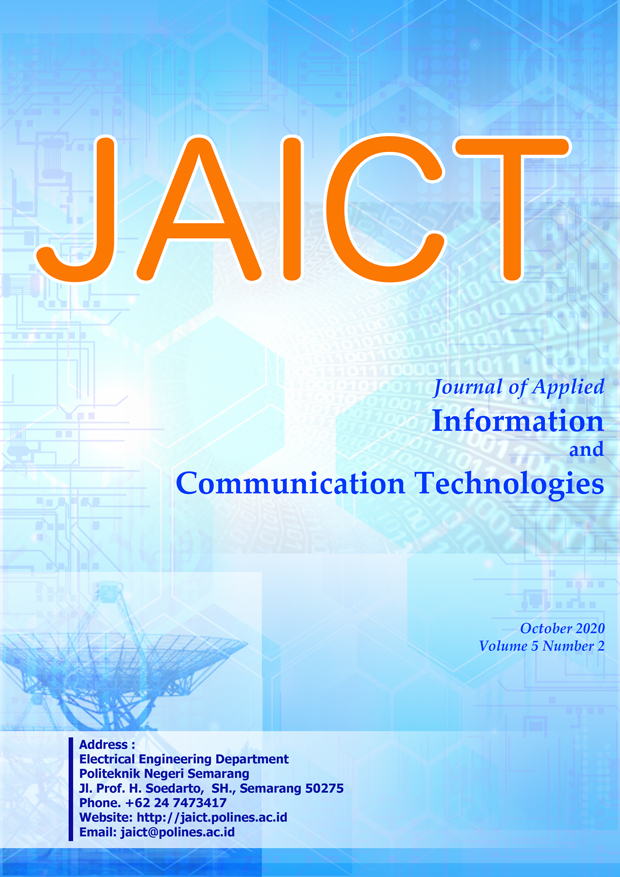Fuzzy Integration to Standard Calculation of K-Nearest Neighbour Attributes
DOI:
https://doi.org/10.32497/jaict.v5i2.1984Keywords:
attribute normalization, fuzzy integration, KNNAbstract
The development of information and data in the era of the industrial revolution 4.0 is very fast. Researchers, institutions and even industry are competing to find and utilize methods in data processing that are more effective and efficient. In data mining classification, there are several best methods and are widely used by researchers. One of them is K-Nearest Neighbor (KNN). The calculation process in the KNN algorithm is carried out by comparing the testing data to all existing training data. This comparison is generally symbolized by the value of closeness or similarity between attribute records. The KNN method is proven to be good for handling large datasets and datasets with many attributes. One of the drawbacks in calculating the similarity of the KNN is that if there are attributes with a large range value, the similarity value will also be large. Conversely, if the range in an attribute is small, the similarity is also small. This condition is clearly unfair considering the types of attributes in the current data vary widely. One solution to this problem is to use standardization for all existing data attributes. Fuzzy is a model introduced by Prof. Zadeh which allows a faint value to be a value between 1 and 0. In this study the fuzzy model will be integrated in the KNN similarity calculation to obtain standardization of all data attributes. The results show that the use of the KNN algorithm in the classification of credit approval has an accuracy rate of 91.83%.
References
Bawono, Aditya Hari, and Ahmad Afif Supianto. 2019. “Efisiensi Klasifikasi Big Data Menggunakan Improved Neighbour” 6 (6): 1”“6. https://doi.org/10.25126/jtiik.201962085.
Cover, T M, and P E Hart. 1967. “Nearest Neighbor Pattern Classification” I.
Gamadarenda, ikhsan wisnuadji, and Indra Waspada. 2018. “Implementasi Data Mining Untuk Deteksi Penyakit Ginjal Kronis (Pgk) Menggunakan K-Nearest Neighbor (Knn) Dengan Backward Elimination” 7 (2): 417”“26. https://doi.org/10.25126/jtiik.202071896.
Gorunescu, Florin. 2011. Data Mining: Concepts; Models and Techniques. Springer.
Indrayanti, Indrayanti, Sugianti Devi, and M. Adib Al Karomi. 2017. “Peningkatan Akurasi Algoritma KNN Dengan Seleksi Fitur Gain Ratio Untuk Klasifikasi Penyakit Diabetes Mellitus.” IC-TECH XIII (2): 1”“6.
Karomi, M. Adib Al, Much. Rifqi Maulana, Slamet Joko Prasetiyono, Ivandari, and Arochman. 2019. “Strengthening Campus Finance by Analyzing Attribute Attributes for Student Registration Classifications.” https://jurnal.polines.ac.id/index.php/jaict/article/view/1431.
Karomi, M Adib Al. 2015. “Optimasi Parameter K Pada Algoritma KNN Untuk Klasifikasi Heregistrasi Mahasiswa Program Studi Teknik Informatika STMIK Widya Pratama Jl . Patriot 25 Pekalongan Email : Adib.Comp@gmail.Com.” IC-TECH X (0285): 5.
Kusrini, and Luthfi Emha Taufiq. 2009. Algoritma Data Mining. Yogyakarta: Andi Offset.
Larose, Daniel T. 2005. Discovering Knowledge in Data: An Introduction to Data Mining. John Wiley & Sons.
Prasetyo, Eko. 2012. Data Mining Konsep Dan Aplikasi Menggunakan Matlab. Yogyakarta: Andi Offset.
Santosa, Budi. 2007. Data Mining Teknik Pemanfaatan Data Untuk Keperluan Bisnis. Edisi Pert. Yogyakarta: Graha Ilmu.
Sets, Fuzzy. 1997. “Toward a Theory of Fuzzy Information Granulation and Its Centrality in Human Reasoning and Fuzzy Logic” 90: 111”“27.
Singh, Harpreet, Madan M Gupta, Thomas Meitzler, Zeng-guang Hou, Kum Kum Garg, Ashu M G Solo, and Lotfi A Zadeh. 2013. “Real-Life Applications of Fuzzy Logic” 2013.
Susanto, Sani, and Dedi Suryadi. 2010. Pengantar Data Mining: Menggali Pengetahuan Dari Bongkahan Data. Yogyakarta: Andi Offset.
Witten, I. H., E. Frank, and M. A. Hall. 2011. Data Mining: Practical Machine Learning Tools and Techniques 3rd Edition. Vol. 40. Elsevier. https://doi.org/10.1002/1521-3773(20010316)40:6<9823::AID-ANIE9823>3.3.CO;2-C.
Witten, Ian H, Eibe Frank, and Mark A. Hall. 2011. Data Mining: Practical Machine Learning Tools and Techniques 3rd Edition. Elsevier.
Wu, Xindong. 2009. The Top Ten Algorithms in Data Mining. Edited by Vipin Kumar. New York: Taylor & Francis Group, LLC.
Downloads
Additional Files
Published
Issue
Section
License
Authors who publish with this journal agree to the following terms:Authors retain copyright and grant the journal right of first publication with the work simultaneously licensed under a Creative Commons Attribution License that allows others to share the work with an acknowledgement of the work's authorship and initial publication in this journal.
Authors are able to enter into separate, additional contractual arrangements for the non-exclusive distribution of the journal's published version of the work (e.g., post it to an institutional repository or publish it in a book), with an acknowledgement of its initial publication in this journal.
Authors are permitted and encouraged to post their work online (e.g., in institutional repositories or on their website) prior to and during the submission process, as it can lead to productive exchanges, as well as earlier and greater citation of published work (See The Effect of Open Access).






